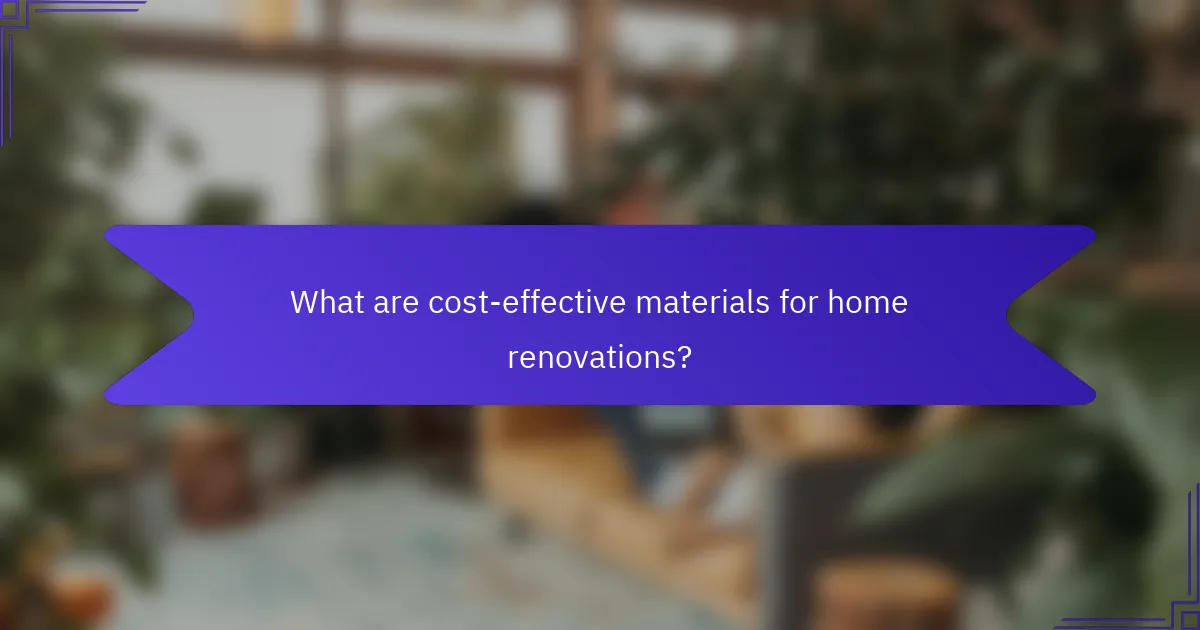Renovating your home on a budget can be both rewarding and achievable, especially for first-time homeowners in Latvia. By focusing on simple yet impactful updates, you can enhance your living space without breaking the bank. Prioritizing essential repairs and selecting cost-effective materials will not only improve comfort but also increase your property’s value.

What are budget-friendly home renovation ideas for first-time homeowners in Latvia?
Budget-friendly home renovation ideas for first-time homeowners in Latvia include simple updates that enhance aesthetics without significant financial strain. Focusing on cost-effective improvements can make a substantial difference in both comfort and property value.
Painting walls
Painting walls is one of the most cost-effective ways to refresh a home. A new coat of paint can dramatically change the atmosphere of a room, making it feel more inviting and modern. Consider using neutral colors to appeal to a broader audience if you plan to sell in the future.
When selecting paint, look for options that are durable and easy to clean. Brands available in Latvia often offer good quality at reasonable prices, so check local stores for sales or discounts.
Updating fixtures
Updating fixtures, such as light fittings and faucets, can enhance the overall look of your home without breaking the bank. Replacing outdated fixtures with modern designs can improve functionality and aesthetics. Focus on areas like kitchens and bathrooms for the most impact.
Shop at local hardware stores or online marketplaces for affordable options. Look for energy-efficient lighting to save on electricity bills in the long run.
Refinishing cabinets
Refinishing cabinets is a budget-friendly alternative to replacing them entirely. Sanding down and repainting or staining existing cabinets can give your kitchen or bathroom a fresh look. This process is often less expensive than new cabinetry and can be done as a DIY project.
Consider using eco-friendly paints or stains available in Latvia to minimize environmental impact. Ensure proper preparation and sealing to achieve a durable finish.
Landscaping
Landscaping can significantly enhance curb appeal and is often a low-cost renovation option. Simple changes, such as planting flowers, trimming hedges, or adding mulch, can make a big difference. Focus on native plants that require less maintenance and are well-suited to the Latvian climate.
Creating defined garden beds or pathways can also improve the overall look of your yard. Consider using recycled materials for borders to keep costs down.
DIY decor projects
Engaging in DIY decor projects allows homeowners to personalize their space while saving money. Simple projects like creating wall art, refurbishing old furniture, or making decorative pillows can add character to your home.
Utilize local materials and resources to keep expenses low. Online tutorials can provide guidance and inspiration for various projects, making it easier for beginners to get started.

How to prioritize renovations on a budget?
To prioritize renovations on a budget, focus on essential repairs and improvements that enhance safety, functionality, and value. Start by identifying the most pressing needs and allocate funds accordingly to avoid overspending on less critical upgrades.
Assessing needs vs. wants
Begin by distinguishing between needs and wants in your renovation plans. Needs are essential repairs, such as fixing leaks or updating electrical systems, while wants might include aesthetic upgrades like new countertops or paint colors.
Create a list of all potential renovations, categorizing them into needs and wants. This will help you allocate your budget effectively, ensuring that critical areas are addressed first before considering optional enhancements.
Creating a renovation timeline
Developing a renovation timeline is crucial for managing your budget and expectations. Start by outlining the sequence of projects based on urgency and impact, allowing for a logical flow of work that minimizes disruptions.
Consider setting realistic deadlines for each phase, keeping in mind the availability of materials and contractors. A well-structured timeline can help you avoid costly delays and ensure that your renovations are completed efficiently.

What are cost-effective materials for home renovations?
Cost-effective materials for home renovations include options that provide good quality at a lower price point. These materials help first-time homeowners achieve their renovation goals without overspending.
Recycled materials
Recycled materials are an excellent choice for budget-friendly renovations. They often come from deconstructed buildings and can include wood, metal, and glass. Using these materials not only saves money but also supports sustainability.
When considering recycled options, check local suppliers or salvage yards. You may find unique pieces that add character to your home while being cost-effective.
Laminate flooring
Laminate flooring is a popular alternative to hardwood due to its affordability and ease of installation. It typically costs significantly less than traditional wood floors, making it a great option for budget-conscious homeowners.
Laminate is available in various styles and finishes, allowing you to mimic the look of natural wood or stone. Ensure you choose a high-quality laminate to enhance durability and longevity.
Budget-friendly tiles
Budget-friendly tiles, such as ceramic or vinyl, can transform spaces without breaking the bank. These tiles are often more affordable than natural stone or porcelain, making them suitable for kitchens and bathrooms.
When selecting tiles, consider their durability and maintenance requirements. Look for sales or bulk purchasing options to maximize savings while achieving a stylish look.

How to find reliable contractors in Latvia?
Finding reliable contractors in Latvia involves researching their reputation, checking their credentials, and comparing quotes. Prioritize contractors with positive reviews and a solid track record to ensure quality work within your budget.
Checking reviews
Start by looking for online reviews on platforms like Google, Facebook, or local forums. Pay attention to both positive and negative feedback to get a balanced view of the contractor’s performance.
Ask for references from previous clients and contact them to inquire about their experiences. A contractor with a history of satisfied customers is more likely to deliver quality work.
Getting multiple quotes
Request quotes from at least three different contractors to compare pricing and services. Ensure that each quote includes a detailed breakdown of costs, materials, and timelines.
Be cautious of quotes that are significantly lower than others, as they may indicate subpar quality or hidden costs. A reasonable range for home renovation projects in Latvia typically varies based on the scope of work, so use your gathered quotes to gauge what is fair.

What are common mistakes to avoid during renovations?
Common mistakes during renovations include underestimating costs and ignoring necessary permits. Avoiding these pitfalls can save time, money, and legal issues.
Underestimating costs
Many first-time homeowners fail to accurately estimate renovation costs, leading to budget overruns. It’s crucial to account for materials, labor, and unexpected expenses, which can add up quickly.
A good rule of thumb is to add an extra 10-20% to your budget for unforeseen costs. For example, if your initial budget is 5,000 EUR, plan for a total of 5,500 to 6,000 EUR to cover surprises.
Ignoring permits
Neglecting to obtain the necessary permits can result in fines and the need to redo work. Many renovations, especially structural changes, require approval from local authorities.
Before starting any project, check with your local municipality to understand which permits are needed. This can prevent delays and ensure that your renovation complies with building codes and regulations.

How to incorporate energy-efficient upgrades?
Incorporating energy-efficient upgrades can significantly reduce utility bills and enhance comfort in your home. Focus on simple changes that improve energy use, such as installing LED lighting and upgrading insulation.
Installing LED lighting
Switching to LED lighting is one of the easiest energy-efficient upgrades for homeowners. LEDs use significantly less energy than traditional incandescent bulbs, often consuming about 75% less electricity and lasting up to 25 times longer.
When replacing your home’s lighting, consider the brightness (measured in lumens) and color temperature (measured in Kelvins) to achieve the desired ambiance. For example, a warm white light (around 2700K) is ideal for living spaces, while cooler temperatures (5000K) work well in work areas.
To maximize savings, look for ENERGY STAR certified LED bulbs, which meet strict efficiency guidelines. This small investment can lead to noticeable reductions in your monthly energy costs.
Upgrading insulation
Improving insulation is crucial for maintaining a comfortable home and reducing energy consumption. Proper insulation helps keep your home warm in winter and cool in summer, leading to lower heating and cooling costs.
Common areas to insulate include attics, walls, and basements. For example, adding fiberglass batts or spray foam insulation can enhance thermal performance. It’s essential to check local building codes and consider hiring a professional for installation to ensure effectiveness.
Evaluate your current insulation by checking for drafts or cold spots, and aim for R-values that meet or exceed local recommendations. Investing in quality insulation can yield significant long-term savings on energy bills.
